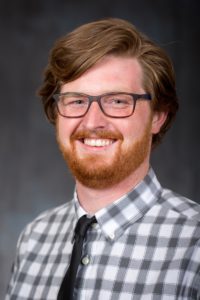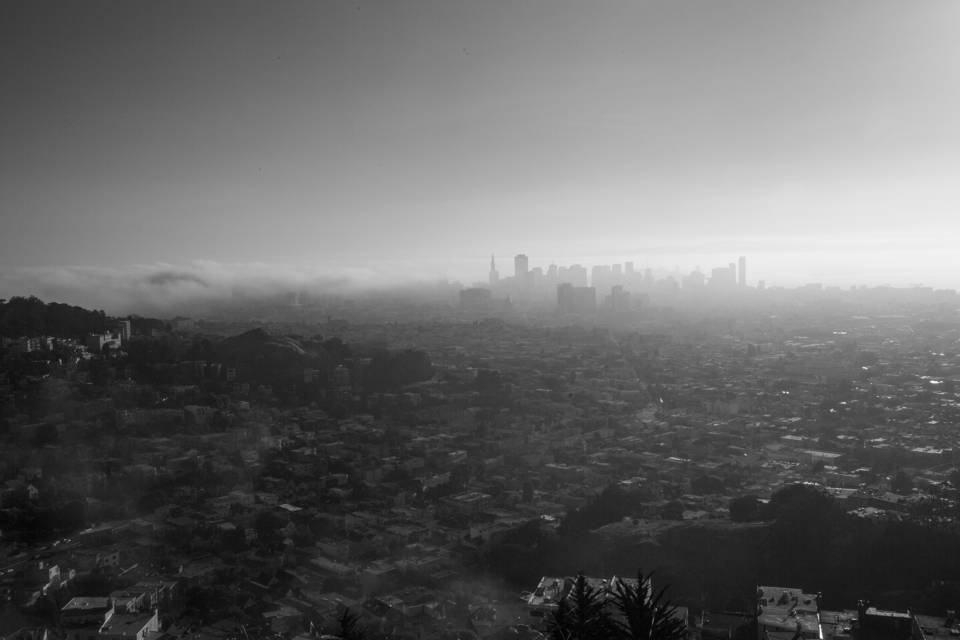Dillon Deaton
Second Place
University of North Carolina at Chapel Hill
$4,000 Scholarship Award and Hearst Medallion

 Heavy fog rolls over San Francisco as the sun rises on Tuesday, May 31, 2016. San FranciscoÕs demographic is rapidly changing due to gentrification and increasing costs of real estate. The booming technology sector in Silicon Valley has caused rapid growth the wage scale, causing an increase in wealth inequality. This wealth inequality has become increasingly troubling for residents in the Bay Area because of the high costs of living and real estate.
Heavy fog rolls over San Francisco as the sun rises on Tuesday, May 31, 2016. San FranciscoÕs demographic is rapidly changing due to gentrification and increasing costs of real estate. The booming technology sector in Silicon Valley has caused rapid growth the wage scale, causing an increase in wealth inequality. This wealth inequality has become increasingly troubling for residents in the Bay Area because of the high costs of living and real estate. Technology workers wait in line to get on a shuttle bus that in the Castro district of San Francisco on Tuesday, May 31, 2016. Often called "Google Buses," these shuttles are provided by many large technology companies, including Facebook and Apple. Many residents associate these shuttles to the increasing gentrification in San Francisco.
Technology workers wait in line to get on a shuttle bus that in the Castro district of San Francisco on Tuesday, May 31, 2016. Often called "Google Buses," these shuttles are provided by many large technology companies, including Facebook and Apple. Many residents associate these shuttles to the increasing gentrification in San Francisco. Christoph Underwood stands for a portrait outside of the San Francisco Public Library on Tuesday, May 31, 2016. After leaving his job in Silicon Valley due to substance abuse, Underwood now lives in a Single-Room Occupancy (S.R.O) in the Mission district of San Francisco. SRO's are primarily rented out in longterm periods to low-income residents and partially subsidized by the Department of Housing and Urban Development. These rooms are typically a solution for those who struggle with the wealth inequality that exists in the city.
Christoph Underwood stands for a portrait outside of the San Francisco Public Library on Tuesday, May 31, 2016. After leaving his job in Silicon Valley due to substance abuse, Underwood now lives in a Single-Room Occupancy (S.R.O) in the Mission district of San Francisco. SRO's are primarily rented out in longterm periods to low-income residents and partially subsidized by the Department of Housing and Urban Development. These rooms are typically a solution for those who struggle with the wealth inequality that exists in the city. Laguna 55, a new community center for low income senior citizens, is being constructed near the Castro district in San Francisco. Although certain laws prevent the program from renting specifically to certain residents, the housing is being heavily marketed to those residents who identify as queer or LGBT. This housing program will be the first affordable, LGBT welcoming housing when it opens in fall 2016.
Laguna 55, a new community center for low income senior citizens, is being constructed near the Castro district in San Francisco. Although certain laws prevent the program from renting specifically to certain residents, the housing is being heavily marketed to those residents who identify as queer or LGBT. This housing program will be the first affordable, LGBT welcoming housing when it opens in fall 2016. San Francisco has a thriving tourist economy due to the ethnic and cultural communities, such as the gay community in the Castro district. This queer and LGBT community is being removed due to the increasing wealth inequality and high prices of real estate.
San Francisco has a thriving tourist economy due to the ethnic and cultural communities, such as the gay community in the Castro district. This queer and LGBT community is being removed due to the increasing wealth inequality and high prices of real estate. Signs and posters advocating for affordable housing are taped to a door in the Mission Neighborhood Resource Center in San Francisco on Tuesday, May 31, 2016. The Mission Neighborhood Resource Center is home to Jazzie's Place, the nations first homeless shelter lesbian, gay, bisexual and transgender adults in the U.S. The shelter opened to help serve the housing needs of nearly a third of the city's homeless population who identify as LGBT.
Signs and posters advocating for affordable housing are taped to a door in the Mission Neighborhood Resource Center in San Francisco on Tuesday, May 31, 2016. The Mission Neighborhood Resource Center is home to Jazzie's Place, the nations first homeless shelter lesbian, gay, bisexual and transgender adults in the U.S. The shelter opened to help serve the housing needs of nearly a third of the city's homeless population who identify as LGBT.
Once considered a safe haven for those who identified as queer or LGBT, the Castro district is rapidly changing as the wealth inequality in the city increases and many residents are forced to leave in order to find cheaper housing. A building permit marks the start of renovations in an apartment building in the Castro district of San Francisco on Tuesday, May 31, 2016. San FranciscoÕs Rent Ordinance provides a just cause to temporarily evict tenants for the purpose of renovating the building. Evictions in San Francisco have risen 67 percent in the last five years and 83 percent of those are are no fault evictions.
A building permit marks the start of renovations in an apartment building in the Castro district of San Francisco on Tuesday, May 31, 2016. San FranciscoÕs Rent Ordinance provides a just cause to temporarily evict tenants for the purpose of renovating the building. Evictions in San Francisco have risen 67 percent in the last five years and 83 percent of those are are no fault evictions. Activist Tommi Avicolli Mecca stands for a portrait in his office at the House Rights Committee in San Francisco on Tuesday, May 31, 2016. Mecca has been a queer activist and writer for over four decades and now focuses on tenant and affordable house advocacy.
Activist Tommi Avicolli Mecca stands for a portrait in his office at the House Rights Committee in San Francisco on Tuesday, May 31, 2016. Mecca has been a queer activist and writer for over four decades and now focuses on tenant and affordable house advocacy.
According to the San Francisco Human Services Agency, 29% of San Francisco's homeless identify as LGBT. "San Francisco is still a place where people come to get away from homophobic households and homophobic situations...people come here and don't realize how bad the housing situation is," says Mecca. "There's no way you can work a minimum wage job and afford an apartment here." Once considered a safe haven for those who identified as queer or LGBT, the Castro district is rapidly changing as the wealth inequality in the city increases and many residents are forced to leave in order to find cheaper housing.
Once considered a safe haven for those who identified as queer or LGBT, the Castro district is rapidly changing as the wealth inequality in the city increases and many residents are forced to leave in order to find cheaper housing. A man sleeps by a bus stop as the sun begins to set in the Castro district of San Francisco on Tuesday, May 31, 2016. District 9 Supervisor David recently announced that he is introducing legislation that, if passed, would declare a state of emergency regarding homelessness in San Francisco.
A man sleeps by a bus stop as the sun begins to set in the Castro district of San Francisco on Tuesday, May 31, 2016. District 9 Supervisor David recently announced that he is introducing legislation that, if passed, would declare a state of emergency regarding homelessness in San Francisco. Mary Watkins, a Midtown resident for 46 years, speaks to the crowd during a rent control rally outside of the San Francisco Mayor's Office of Housing and Community Development on Wednesday, June 1, 2016. The Midtown Park Apartments Tenants Association and residents called on the city to restore rent controlled prices within the apartment complex. In San Francisco, many tenants are covered under rent control which allows the rent to be raised only a certain amount each year and prevents tenants from being evicted for anything other than "just causes."
Mary Watkins, a Midtown resident for 46 years, speaks to the crowd during a rent control rally outside of the San Francisco Mayor's Office of Housing and Community Development on Wednesday, June 1, 2016. The Midtown Park Apartments Tenants Association and residents called on the city to restore rent controlled prices within the apartment complex. In San Francisco, many tenants are covered under rent control which allows the rent to be raised only a certain amount each year and prevents tenants from being evicted for anything other than "just causes." Phyllis Bowie yells into the mic as she speaks to a crowd during a rent control rally outside of the San Francisco Mayor's Office of Housing and Community Development on Wednesday, June 1, 2016. The Midtown Park Apartments Tenants Association and residents called on the city to restore rent controlled prices within the apartment complex. "The city is trying to force us into the affordable housing bucket where they don't have the funds," says Bowie.
Phyllis Bowie yells into the mic as she speaks to a crowd during a rent control rally outside of the San Francisco Mayor's Office of Housing and Community Development on Wednesday, June 1, 2016. The Midtown Park Apartments Tenants Association and residents called on the city to restore rent controlled prices within the apartment complex. "The city is trying to force us into the affordable housing bucket where they don't have the funds," says Bowie.
In San Francisco, many tenants are covered under rent control which allows the rent to be raised only a certain amount each year and prevents tenants from being evicted for anything other than "just causes." Anthony Tamaribuchi looks over his shoulder to gauge the incoming fog as he watches the sunrise at a lookout on Twin Peaks in San Francisco on Tuesday, May 31, 2016. Tamaribuchi moved to San Francisco from Sacramento when he was four with his mother, who raised him as a single parent.
Anthony Tamaribuchi looks over his shoulder to gauge the incoming fog as he watches the sunrise at a lookout on Twin Peaks in San Francisco on Tuesday, May 31, 2016. Tamaribuchi moved to San Francisco from Sacramento when he was four with his mother, who raised him as a single parent.
Tamaribuchi says he was able to watch the transformation in Sanfrancisco neighborhoods. "The Fillmore is a prime example," says Tamaribuchi. "It's historically famous for jazz and having musical roots... and its largely disappeared because people are getting pushed out. Its losing its diversity. But there are good sides and bad sides," said Tamaribuchi.
"I was lucky to grow up with a single mother...she basically brought us up from nothing. Because of that I have been able to see both sides. I grew up in the rough parts and now I live in kind of a nice part. Its tough because all of my friends have been kicked out, but my mom worked her ass off and pulled us out of that shit."

